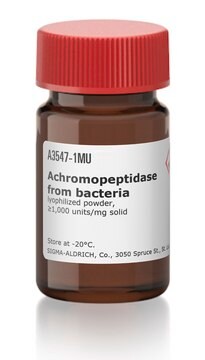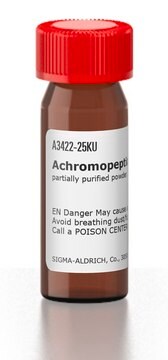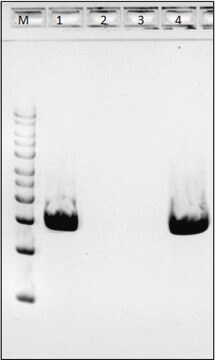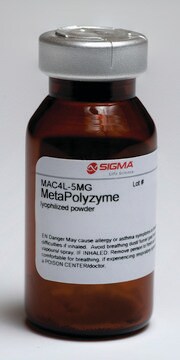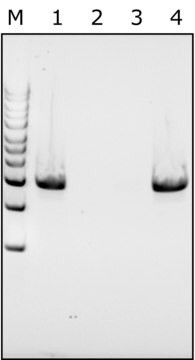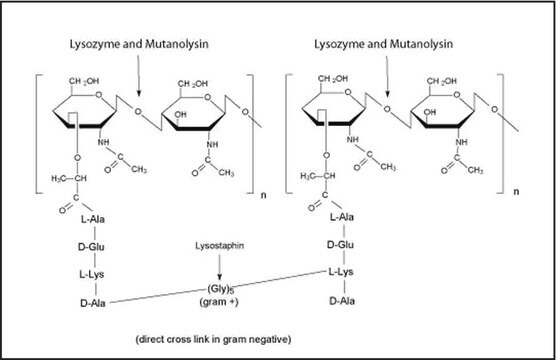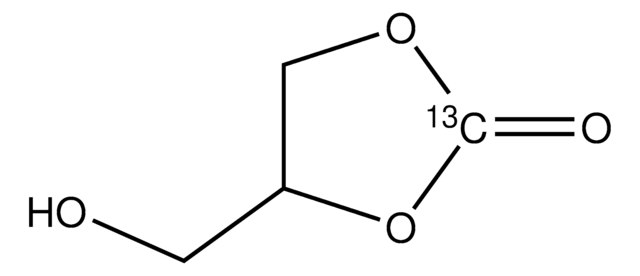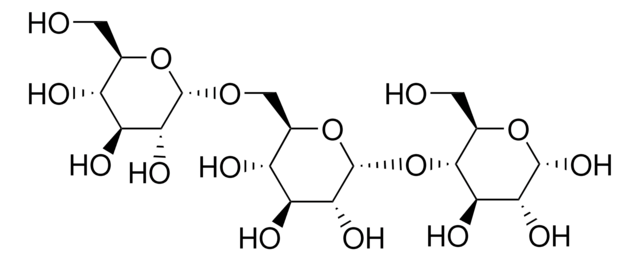A7550
Achromopeptidase from Achromobacter lyticus
lyophilized powder, Protein ~5 % by biuret, 300-600 units/mg solid
Autenticatiper visualizzare i prezzi riservati alla tua organizzazione & contrattuali
About This Item
Numero CAS:
Numero MDL:
Codice UNSPSC:
12352204
Prodotti consigliati
Forma fisica
lyophilized powder
Attività specifica
300-600 units/mg solid
Composizione
Protein, ~5% biuret
Attività estranea
Collagenase, present
Temperatura di conservazione
−20°C
Azioni biochim/fisiol
Achromopeptidase is a lysyl endopeptidase with a MW of ~27 kDa. It is useful for lysis of Gram-positive bacteria that are resistant to lysozyme.
pH Optimum for activity: pH 8.5 - 9
Approximately 500-1,500 un/ml achromopetidase can be used to lyse cells at a density of OD600=0.6 over 2 hours at 37 °C.
pH Optimum for activity: pH 8.5 - 9
Approximately 500-1,500 un/ml achromopetidase can be used to lyse cells at a density of OD600=0.6 over 2 hours at 37 °C.
Definizione di unità
One unit will produce a change in A600 of 0.001 per minute per mL at pH 8.0 at 37 °C using a suspension of Micrococcus lysodeikticus as substrate (1 cm light path).
Stato fisico
Crude powder containing salts and medium components
Avvertenze
Danger
Indicazioni di pericolo
Consigli di prudenza
Classi di pericolo
Resp. Sens. 1
Codice della classe di stoccaggio
11 - Combustible Solids
Classe di pericolosità dell'acqua (WGK)
WGK 3
Punto d’infiammabilità (°F)
Not applicable
Punto d’infiammabilità (°C)
Not applicable
Dispositivi di protezione individuale
dust mask type N95 (US), Eyeshields, Faceshields, Gloves
Certificati d'analisi (COA)
Cerca il Certificati d'analisi (COA) digitando il numero di lotto/batch corrispondente. I numeri di lotto o di batch sono stampati sull'etichetta dei prodotti dopo la parola ‘Lotto’ o ‘Batch’.
Possiedi già questo prodotto?
I documenti relativi ai prodotti acquistati recentemente sono disponibili nell’Archivio dei documenti.
Beatrice Quevedo et al.
BMC microbiology, 11, 14-14 (2011-01-21)
The purpose of this study was to design and evaluate fluorescent in situ hybridization (FISH) probes for the single-cell detection and enumeration of lactic acid bacteria, in particular organisms belonging to the major phylogenetic groups and species of oral lactobacilli
Niamh Toomey et al.
Applied and environmental microbiology, 75(10), 3146-3152 (2009-03-10)
Three wild-type dairy isolates of lactic acid bacteria (LAB) and one Lactococcus lactis control strain were analyzed for their ability to transfer antibiotic resistance determinants (plasmid or transposon located) to two LAB recipients using both in vitro methods and in
T Masaki et al.
Biochimica et biophysica acta, 660(1), 44-50 (1981-07-24)
Achromobacter lyticus M497-1 produces three kinds of alkaline proteases (protease I, II and III) in culture medium along with the bacteriolytic enzyme (Masaki, T., Nakamura, K., Isono, M. and Soejima, M. (1978) Agric. Biol. Chem. 42, 1443--1445). Among these three
T Masaki et al.
Biochimica et biophysica acta, 660(1), 51-55 (1981-07-24)
The unique specificity of Achromobacter protease I for lysine residue was investigated using synthetic and natural substrates, i.e., lysine derivatives, arginine derivatives, lysine vasopressin, substance P, ACTH and insulin. The enzyme cleaved only the -Lys-X- bonds in the above substrates.
Raju Sekar et al.
Applied and environmental microbiology, 69(5), 2928-2935 (2003-05-07)
We tested a previously described protocol for fluorescence in situ hybridization of marine bacterioplankton with horseradish peroxidase-labeled rRNA-targeted oligonucleotide probes and catalyzed reporter deposition (CARD-FISH) in plankton samples from different lakes. The fraction of Bacteria detected by CARD-FISH was significantly
Il team dei nostri ricercatori vanta grande esperienza in tutte le aree della ricerca quali Life Science, scienza dei materiali, sintesi chimica, cromatografia, discipline analitiche, ecc..
Contatta l'Assistenza Tecnica.